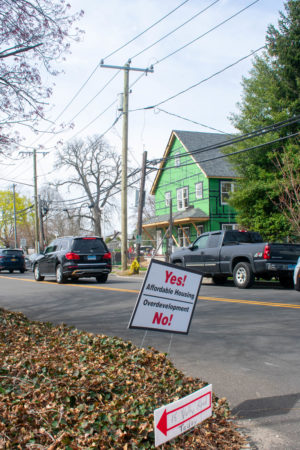Affordable housing in Greenwich? Two very different strategies are explored

Photo by Justin McGown.
The state of affordable housing within Greenwich was the focus of an April 14 meeting at the Greenwich Water Club chaired by Katie DeLuca, the town’s director of planning and zoning, and state Sen. Ryan Fazio (R-36th District).
Since 1989, every municipality in Connecticut has been required by law to ensure that at least 10% of all housing stock within their borders is affordable housing as defined by a series of complex metrics. But Greenwich, not unlike the overwhelming majority of communities across the state, has never hit that 10% goal. In 2021, 5.3% of Greenwich’s housing stock, or 1,380 total units, were considered affordable, marking the closest the town has ever come to the 10% level.
However, the definition of “affordable” has become something of a moving target —state law defined different varieties of affordable housing as being roughly one-third of the income of a family earning a certain percentage of the median income. For 2021-2022, Connecticut’s median income was set at $65,045.24 for an individual, but in Greenwich the median income for an individual for that same period is over $99,000.
In most cases, the law indicates that the lower of the two numbers should be used to determine what level of income constitutes affordable housing.
“Affordable housing as the state defines it will not satisfy the needs of our teachers, police, fire,” said DeLuca. “The reason being the entry level salaries in town are too high according to the definitions that the state has put forth.
A Personal Connection
DeLuca shared that her niece, a teacher in Greenwich public schools, is one of several educators who check for openings in 4 Orchard St. every morning. The property is one of the limited quantity of “set-aside” housing developments in Greenwich and contains 15 affordable housing units according to the statewide rate —but these units, which are in high demand, rarely go on the market.
Even if a teacher were the first to apply for one of those units, they would be disqualified on the basis of their income even though they may not be able to afford anywhere else in town, DeLuca said.
However, while the housing units, which developers are required to include in multifamily construction have their affordability determined by the state median, housing stock constructed by municipal housing authorities such as Greenwich Communities (the name of the Greenwich Housing Authority since 2020) is automatically set at the local level.
Affordable housing constructed as a percentage of a new development and that has metrics based off whichever median income is lowest is called “held aside” housing. “Assisted housing” constructed with public funds by a municipality or housing authority always has the definition of affordable defined off the local median.
In the past, DeLuca observed, traffic concerns, conservation and preservation goals, and strict zoning forced developers to reduce the amount of affordable units they constructed. Highlighting those issues alongside a desire to maintain Greenwich’s “standard of living,” DeLuca and her team developed a solution to come closer to compliance without relying on independent developers.
“What we decided to do was create an affordable housing trust fund,” she said. “The idea behind this trust fund is to —through donations —be able to use that money to entice people to create assisted housing versus set aside housing.”
Alongside the trust fund, DeLuca presented six methods listed in order of preference that can be used to increase Greenwich’s affordable housing stock.
The first is to convert existing houses, particularly ones which had previously been repurposed for office space, into affordable housing. Second is promoting the construction of new affordable housing with an emphasis on rental units. Third is to encourage what DeLuca called “deeper affordability” by encouraging that larger existing homes be used for multifamily units.
DeLuca said the fourth step is “to mitigate the size and scope of proposed mixed income buildings and include affordable housing units.” The fifth and sixth steps are deepening affordability by increasing the length of time that units are deed restricted and encouraging more workforce housing units aimed at teachers or municipal employees respectively.
Additionally, DeLuca said plans to reexamine zoning laws for accessory dwelling units and possibly encourage the development of more through a tax rebate are being considered.
A Different Consideration
Fazio outlined both the efforts of some legislators to empower the law and his party’s work to shift more control to the local level.
“We’re dealing with a very, very dense and complex issue,” Fazio said. “Sometimes I think these issues are designed that way in Hartford intentionally to make it more difficult for the regular citizens of individual towns to understand exactly what is happening and why.”
Pointing out the fact that only 31 of the 169 municipalities in Connecticut have hit the 10% affordable housing goal while poverty has risen across the state in the past 30 years, Fazio argued that the solution to a lack of housing was increased economic prosperity.
Fazio also discussed a bill he supported, which will sidestep the need for creating large numbers of affordable housing units by widening the definitions to include more of Greenwich’s already existing housing stock.
“The bill we submitted tries to get at that point,” Fazio said of legislation he is sponsoring, “that the 40-year deed restrictions undercount the amount of affordable housing in our opinion. I understand the need for the deed restriction, I understand why it exists, but I do not think it makes for an accurate reflection of reality.”